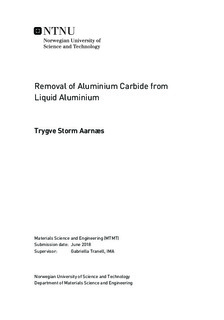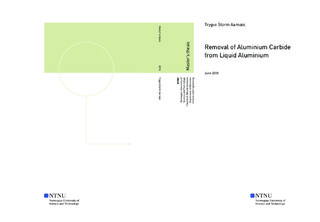| dc.description.abstract | Aluminium carbide (Al4C3) inclusions are a common type of impurity found in aluminium alloys. Currently aluminium carbide cannot be efficiently removed due to its small particle size and wetting properties. The small carbide inclusions can lead to surface defects, in addition some products have a very low tolerance for carbide content.
In this project it was attempted to remove carbide inclusions from aluminium, which was sampled from an electrolysis cell. Preliminary experiments indicated H2O in argon to be a promising candidate for a gas based removal strategy. [1] Experiments were performed in a lab-scaled furnace, with gas mixes with 1% and 2% H2O in argon. Additional experiments to examine the effect of remelting aluminium at 700C, 750C and 800C were performed. The carbide content of the metal was examined before, right after melting and after each experiment, dross samples were also analysed. The off-gas was analysed by an FTIR-spectrometer.
Secondary experiments aimed towards examining the formation of carbide was also performed. Carbide was formed by heating pure aluminium to 1100C in a graphite crucible. Afterwards the samples were examined in SEM.
A setup was built which is capable of performing gas injection into molten aluminium. In the off-gas methane was detected, which is evidence of chemical removal of carbide. The remelting experiments gave a reduction in carbide content which increases with temperature. Metallographic analysis found appearance and size of the carbide inclusions to be in line with previous observations. [2]
This thesis first attempts to gain an overview of existing research relating to the removal of Al4C3. Then results are presented concerning the carbide removal ability of the different reactive gases, as well as the off-gas compositions. Lastly different mechanisms explaining the observed behaviour is proposed. | |

